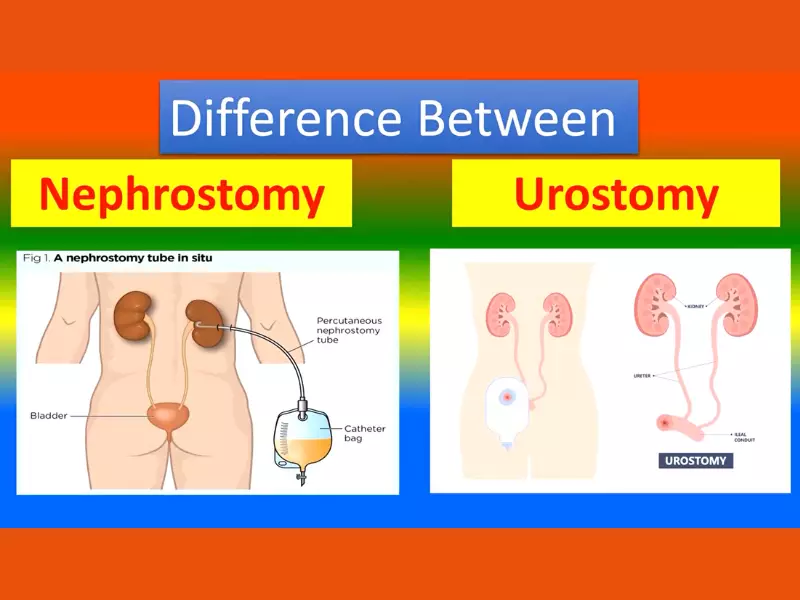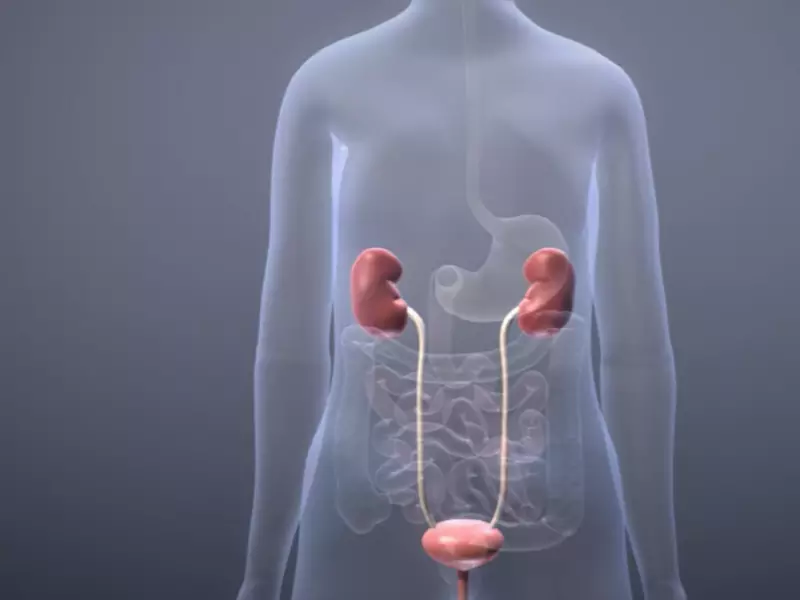The urinary system plays a critical role in maintaining our body’s balance by removing waste and excess fluid. However, certain medical conditions can hinder its function, necessitating surgical interventions to aid in waste elimination. Two such procedures, nephrostomy and urostomy, offer different approaches for addressing urinary system issues but often lead to confusion due to their similar-sounding names and purposes.
A nephrostomy is a surgical procedure that creates an opening between the kidney and the skin to divert urine directly from the kidney, bypassing the bladder. A urostomy, on the other hand, involves creating a stoma or opening in the abdomen for urine to exit the body after the bladder has been bypassed or removed. Both procedures are employed to ensure urine can still be expelled from the body when normal pathways are disrupted.
Understanding the differences between these procedures is crucial for patients facing urinary system surgeries. It aids in setting realistic expectations, preparing for post-surgical life, and making informed decisions regarding their health and lifestyle. Each procedure has its indications, benefits, and management strategies, highlighting the importance of patient education and healthcare provider consultation.

Nephrostomy Overview
Definition and Purpose
What is a nephrostomy?
A nephrostomy is a medical procedure where a tube, known as a nephrostomy tube, is inserted through the skin directly into the kidney. This tube helps in draining urine from the kidney to the outside of the body into a collecting bag. This procedure is typically used when the normal flow of urine is blocked.
Reasons for a nephrostomy
Nephrostomy is performed for several reasons, including:
- Blocked ureters: Conditions like kidney stones, tumors, or infections can block the ureters, preventing urine from flowing to the bladder.
- Surgery recovery: After kidney surgery, it might be necessary to divert urine to allow healing.
- Kidney infections: To drain infected urine directly from the kidney.
- Hydronephrosis: Swelling of a kidney due to a build-up of urine.
Procedure Details
How is it performed?
The nephrostomy procedure is usually done under local anesthesia and sometimes with sedation. Here are the steps:
- Imaging guidance: Ultrasound or CT scans are used to locate the kidney and plan the insertion point.
- Anesthesia: Local anesthesia is applied to numb the area.
- Tube insertion: A needle is first inserted into the kidney. A wire is passed through the needle to serve as a guide for the nephrostomy tube.
- Tube placement: The tube is inserted over the guide wire, and the wire is removed. The tube’s position is confirmed with imaging.
Pre and post-procedure care
- Pre-procedure: Patients may need to fast for a few hours before the procedure.
- Post-procedure: Pain management is important. The site and tube require regular cleaning to prevent infection.
Urostomy Overview
Definition and Purpose
What is a urostomy?
A urostomy, specifically an ileal conduit urostomy, is a surgical procedure that creates a new way for urine to exit the body after the bladder has been removed or bypassed. A piece of the intestine is used to create a conduit for urine to pass from the ureters to the outside of the body.
Reasons for a urostomy
Urostomies are typically performed due to:
- Bladder cancer: Leading to the removal of the bladder.
- Severe bladder dysfunction: Not manageable by other treatments.
- Birth defects: Affecting the normal function of the urinary system.
Procedure Details
How is it performed?
The urostomy procedure involves several steps under general anesthesia:
- Removing a piece of the intestine: A small piece of the intestine is used to create the conduit.
- Connecting ureters: The ureters are detached from the bladder and connected to the isolated piece of the intestine.
- Creating the stoma: The other end of the intestine is brought out through the abdominal wall to form a stoma.
Pre and post-procedure care
- Pre-procedure: Pre-surgical assessments and bowel preparation are required.
- Post-procedure: Learning to care for the stoma and the use of ostomy appliances is crucial for post-operative recovery.
Key Differences
Physical Differences
Location and appearance
- Nephrostomy: Involves a tube coming from the back, near the kidney area, draining into a bag.
- Urostomy: Involves a stoma on the abdomen, where urine drains into a pouch attached to the skin.
How they work
- Nephrostomy: Directly drains urine from the kidney.
- Urostomy: Diverts urine through a piece of the intestine to the stoma.
Surgical Considerations
Procedure complexity
- Nephrostomy: Less invasive, can be done under local anesthesia.
- Urostomy: More complex, requiring general anesthesia and surgical creation of a stoma.
Recovery and healing
- Nephrostomy: Shorter recovery time, less post-operative care.
- Urostomy: Longer recovery, involves learning stoma care and life-long management.
Long-Term Management
Daily care requirements
- Nephrostomy: Regular tube and site cleaning, monitoring for signs of infection.
- Urostomy: Daily stoma and appliance care, skin protection.
Lifestyle adjustments
- Nephrostomy: Temporary lifestyle adjustments, mostly during recovery.
- Urostomy: Permanent adjustments in daily routines, including activities, clothing, and travel.
Both nephrostomy and urostomy procedures play vital roles in managing serious urinary system conditions. They require careful consideration, preparation, and post-operative care to ensure the best possible outcomes for patients. Understanding these differences helps patients and caregivers make informed decisions and adjust to the changes these procedures bring to their lives.

Choosing Between Nephrostomy and Urostomy
Making a decision between a nephrostomy and a urostomy involves careful consideration of medical criteria, doctor’s recommendations, and patient considerations. Both procedures offer life-saving solutions under different conditions, but they come with their own sets of impacts and requirements for the patient’s quality of life. Understanding these factors is essential for making an informed decision.
Medical Criteria
Conditions Best Suited for Each
Nephrostomy is often recommended when the issue is localized to the kidneys or the upper urinary tract. Conditions that might necessitate a nephrostomy include:
- Severe ureteral obstruction
- Kidney stones that cannot be removed by less invasive methods
- Tumors causing blockage of the urinary tract
- Infections within or around the kidney
Urostomy, on the other hand, is considered when the bladder needs to be bypassed or removed due to conditions such as:
- Bladder cancer requiring cystectomy (bladder removal)
- Irreparable damage to the bladder from injury or illness
- Birth defects affecting urinary system function
Doctor’s Assessment and Recommendations
The choice between nephrostomy and urostomy is heavily reliant on a thorough doctor’s assessment, which includes:
- Diagnostic tests like CT scans, MRIs, and ultrasounds to understand the extent of the disease or damage
- Evaluation of the patient’s overall health and ability to undergo surgery
- Consideration of previous treatments and their outcomes
Doctors recommend a procedure based on the least invasive option with the best prognosis for the patient. The decision is made with the patient’s health and quality of life as the priority.
Patient Considerations
Quality of Life Impacts
Both procedures have significant impacts on a patient’s quality of life, but these impacts vary based on the individual’s condition and lifestyle. Quality of life considerations include:
- Nephrostomy:
- Temporary versus permanent necessity
- Ability to manage the care of the external tube and bag
- Impact on mobility and daily activities
- Urostomy:
- Permanent change with no reversal
- Learning to care for the stoma and manage ostomy appliances
- Adjustments in lifestyle, clothing, and activities
Patients often benefit from counseling and support groups to adapt to these life changes. The emotional and psychological aspects of living with a nephrostomy or urostomy cannot be understated and require comprehensive support.
Patient Preferences and Concerns
When deciding between a nephrostomy and urostomy, patient preferences play a crucial role. These might include:
- Desire for the least invasive option: Some patients may opt for a nephrostomy to avoid bladder removal.
- Concerns about visibility and management: The visible nature of a urostomy bag and the care involved might influence the decision.
- Long-term health considerations: Patients may consider their ability to manage long-term care and complications.
Open dialogue between the patient and healthcare providers ensures that all concerns are addressed. Patients should feel empowered to ask questions about:
- The risks and benefits of each procedure
- Post-operative care and lifestyle changes
- Support services available, including psychological support and rehabilitation
Making the Decision
Choosing between a nephrostomy and urostomy involves a collaborative approach. Patients should consider:
- Gathering as much information as possible about each procedure
- Discussing potential outcomes and lifestyle impacts with healthcare providers
- Considering personal values and lifestyle preferences in the context of medical advice
Second opinions can also be valuable in making such a life-changing decision. Exploring all options ensures that the chosen procedure aligns with the patient’s health needs and personal circumstances.
FAQs
What conditions necessitate a nephrostomy?
A nephrostomy is often required when there’s a blockage preventing urine from flowing naturally from the kidney to the bladder. Conditions like kidney stones, tumors, or strictures can necessitate this procedure to prevent kidney damage and alleviate symptoms.
How does a urostomy change daily life?
Post-urostomy, patients will need to adapt to life with a stoma, learning to manage and care for their ostomy appliance. While it represents a significant adjustment, with proper education and support, individuals can lead active, fulfilling lives. Attention to hygiene, routine care, and monitoring for complications are essential aspects of daily management.
Can nephrostomy or urostomy be reversed?
Nephrostomy is often a temporary measure and can be reversed once the underlying condition is treated or resolved. Urostomy, however, is usually permanent, especially if it involves the removal of the bladder. Reversibility depends on the type of surgery, the patient’s overall health, and the reason for the procedure.
What are the risks associated with these procedures?
Both procedures carry risks such as infection, bleeding, and blockage of the urine flow. For nephrostomy, there’s also the risk of kidney damage, while urostomy patients may face complications like skin irritation around the stoma or issues with the stoma itself.
Conclusion
Nephrostomy and urostomy are vital surgical procedures that enable individuals facing urinary system challenges to maintain a quality of life. While both aim to bypass natural urinary pathways, they cater to different conditions and require specific post-operative care. Understanding these differences empowers patients to navigate their medical journey with confidence.
Making an informed decision about nephrostomy and urostomy requires thorough discussion with healthcare professionals, coupled with personal research. As medical technology advances, the prognosis for individuals undergoing these procedures continues to improve, offering hope and improved quality of life to those affected by urinary system disorders.
